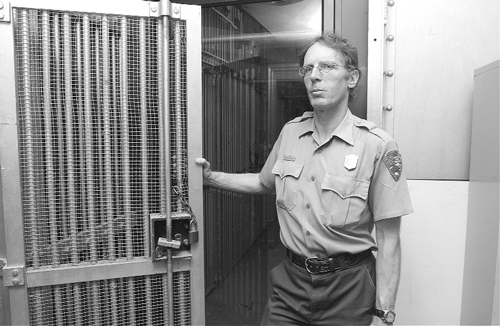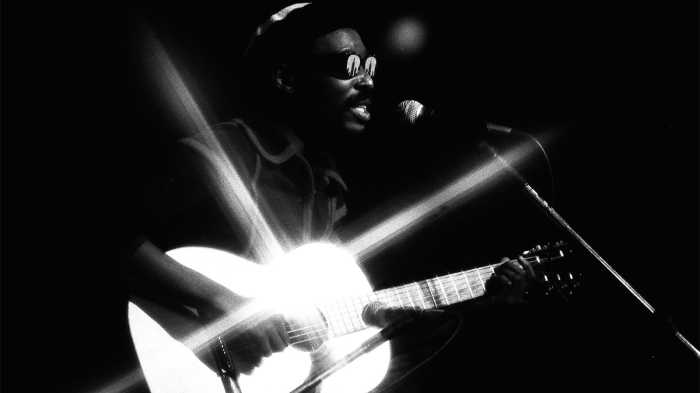By Janet Kwon
Michael Callahan, a National Park Service ranger, near a vault in Federal Hall on Wall St. The museum, which is being renovated, is expected to reopen by Columbus Day.
With curtains shut and windows taped, the newly renovated Federal Hall has yet to reopen its doors. After 16 months of construction at a $16 million cost, the famed building is slated to reopen to the public around the second week of October, Columbus Day weekend.
Surrounded by hurried Wall Streeters with their dangling briefcases and morning lattes, the Federal Hall National Memorial sits at 24 Wall St., across the street from the New York Stock Exchange. The building’s exterior is still covered with a layer of dust from the months of construction, but the overall construction is nearly finished, according to Michael Callahan, a park ranger for the National Park Service.
“Work is still being done on the A.C. system, heating, painting a little bit, and working on the wiring for the phones and computers… it should be done in the next couple of weeks or so,” Callahan said as he stood in the ground floor rotunda.
He added that the U.S. National Archives and Records Administration might display the Bill of Rights on opening day. Also, the New York Baroque Dance Company is scheduled to perform 18th century dance. There are many new coming attractions being added to this revamped museum, but the historical significance of its past remains steadfast.
“This is the birthplace, really, of our present system of democracy — this one site. It’s probably one of the most historical areas in the United States,” he explained.
The original Colonial-style building went up in 1703 and functioned as City Hall until 1788.
“This was the city administration; the mayor was here, the courts were here, the arsenal was here, the fire department was here on this site,” Callahan said.
In 1735, John Peter Zenger, a New York publisher, journalist and editor, was tried and acquitted on charges of sedition and libel at the site of the current museum. His victory made major headway in securing the freedom of the press, explained Callahan.
About 30 years later, George Washington brought the Continental Army to New York City and stationed his headquarters at the Federal Hall site, although for only six brief months. He would later return to the site to be inaugurated as the first president of the United States in 1789, six years after America won independence from Britain in 1783. Parts of the Bill of Rights were written on the site, and the original building served as the nation’s first capitol until 1790, when the capitol moved to Philadelphia.
In 1811, the building was torn down because it was in disrepair and unsalvageable, and City Hall was moved to its current location. The existing building was built in 1842 and served as the U.S. customs house for the port of New York until 1862, when the U.S. Subtreasury took over the building.
“Up to 1,700 tons of gold and silver were kept in the vaults at this site by the 1880s,” Callahan said as he motioned to a tall and deep vault in one corner of the rotunda. Placing his hand on the vault’s thick door with its elaborate maze of locks, Callahan mentioned that there are rows upon rows of such vaults in the basement.
After the Subtreasury moved out in 1920, the building served as the Federal Reserve until 1924, when the building went over to the state department to be used as a federal office building as well as a museum.
The National Park Service took over the building in 1950, and the current renovation is the first major reconstruction since then. On Sept. 11, 2001, the building served as a refuge for people fleeing the World Trade Center sites, and water and medical attention were provided. One year later, on Sept. 6, 2002, a special session of Congress convened at Federal Hall, led by Vice President Dick Cheney. Nearly 300 members of the House and Senate crammed into the building for the special Congressional session — one that hadn’t been held in New York City since 1790.
“It all took place right here, on this one small site. So there is an amazing amount of history here. It’s just incredible,” he said.
Callahan didn’t miss a beat as he strode in and out of various exhibition rooms, weaving in little known anecdotes of famous figures such as George Washington, Alexander Hamilton and John Peter Zenger. Exhibits will be dedicated to these figures, including relevant artifacts that relate to their lives and accomplishments.
For example, the museum has in its possession the very slab of flooring that Washington stood on when he was sworn into office. They also have a piece of the original railing of the second floor balcony as well as the Bible that Washington was sworn in on. Callahan envisions the “Washington Exhibit” including all three items, possibly with the slab on the floor beneath Plexiglas — allowing patrons to walk on it, thereby getting the full experience of the historical moment.
This is just one of a laundry list of possible exhibits that may fill the museum. The museum will have rotating exhibits and will work with many of the 15 Lower Manhattan museums including the Police and Fire Museums. In addition to these various exhibitions, there will also be office space and conference rooms available in the museum.
A large conference room on the first floor of the building will house New York City & Company and the National Parks of New York Harbor. These agencies will run a visitor’s center for the Downtown area.
“Visitors can get information on the various Lower Manhattan parks and museums; if you want to know what to do in Lower Manhattan, this is where you’ll come,” Callahan said, as he paced around the empty first floor space. The basement through the second floor consists of mostly exhibition space and conference rooms, but the third floor will be mostly office space with the main occupant being the office of the commissioner of the National Parks of New York Harbor, Maria Burks.
“We are absolutely thrilled to move in,” said Burks. “The Downtown area there is coming to life now — there is a whole lot of energy and interest coming, and we’re just excited to be a part of that — it’s a perfect fit for us to be there.”
Burks and her staff are currently stationed in Fort Wadsworth in Staten Island and are planning to move in toward the end of the summer.
Callahan said the museum may rent out space for anything from board meetings to weddings. He also wants to attract lunchtime foot traffic by putting on small tours during workers’ lunch hours so that they can have a brief change of scenery from their busy work days.
Burks agreed with this sentiment. “People sit on the steps [of Federal Hall], enjoying a refreshing beverage, and they look at the Stock Exchange across the street, but they never turn around and come inside. We want to change that.”
WWW Downtown Express



































